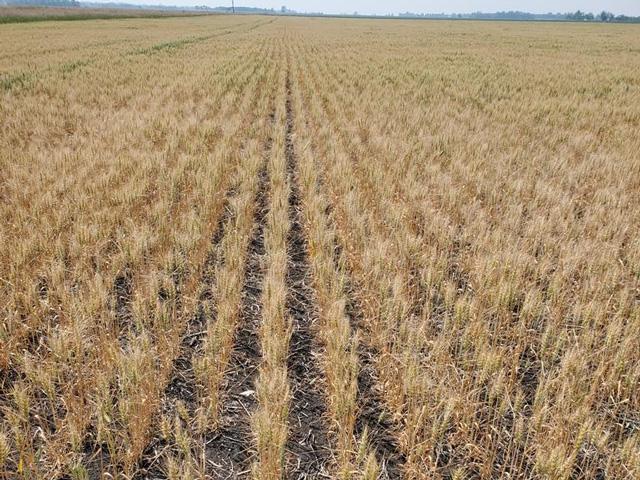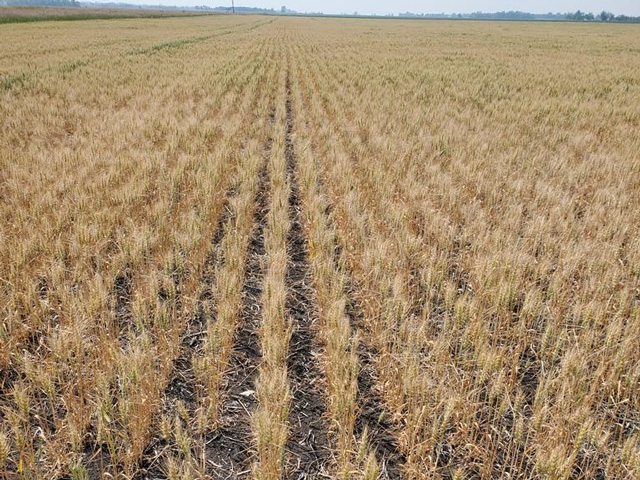Market Matters Blog
2021 Spring Wheat Crop: Good Quality, Poor Yields
The 2021 spring wheat crop fought hard to make it to the finish line this year, but for some, their crop never crossed it. Many acres were abandoned and/or hayed for livestock feed, and others were left to file insurance claims.
In the Aug. 12 USDA Crop Production report, other spring wheat production for grain was forecast at 343 million bushels (mb), down 41% from last year. Based on Aug. 1 conditions, yields were expected to average 30.6 bushels per harvested acre, down 18.0 bushels from 2020. If realized, this would be the lowest yield since 2002 for the United States, USDA said. Of the total production, 305 mb are hard red spring wheat, down 42% from 2020.
Gro Intelligence. in a Sept. 22 spring wheat insight said, "Gro forecasts production could drop even further due to higher abandonment rates. In past years of similar drought conditions, farmers left unharvested 8% of total spring wheat acres in 2017, 15% in 2002, and over 20% in 1988. Currently the USDA is forecasting a 3% harvest loss."
USDA will report harvested acres estimates in its Sept. 30 Small Grains Summary.
"Acreage abandonment rates comparable to previous drought years would reduce total U.S. spring wheat production this year by between 25 million and 60 million bushels, taking the U.S. balance sheet to even tighter territory and adding support to prices that are at their highest levels since 2012," added Gro.
I spoke with Darin Jantzi, State Statistician, USDA/NASS North Dakota field office, about how abandoned and hayed spring wheat acres would be accounted for this year by USDA. "Until the Small Grains Annual Summary is published in late September, NASS really doesn't have any mechanism to account for any abandoned acres or any other unharvested acreage for any crops. Any abandoned wheat acres won't be fully known until we collect that data from producers in early September. That is when we collect final acreage and production data once the producers have harvested their small grain crops."
U.S. Wheat Associates reported that the 2021 spring wheat crop was a No. 1 Dark Northern Spring (DNS), 61.1 pounds and 15.4% on average versus the 2020 crop at No. 1 Northern Spring Wheat (NS), 61.6 pounds and 14.4 protein. To get a perspective on how wheat harvest went this year in North and South Dakota, western Minnesota and eastern Montana, farmers in those states reported their results to DTN.
In northwest Minnesota, Tim Dufault, Crookston, Minnesota, said that his quality was the best he had ever seen. "Test weights were 61-64 pounds on every load and mostly 62-63 lbs. Protein samples were 13.8% to 16.1%, with most of it 14.7% to 15.3%. Yield was as variable as the rainfall this growing season. Some fields that caught a pop-up shower of a couple tenths of rain could be 10 bushels better than another field a mile way.
"My field averages ranged from 36 to 54 bushels per acre (bpa). That's how spotty the rain was. I no-till seeded most of my wheat this spring, and I think that's why I had an edge in yield over neighboring fields, which only were in the 20 bpa range," added Dufault.
P[L1] D[0x0] M[300x250] OOP[F] ADUNIT[] T[]
Darrin Schmidt, eastern North Dakota said, "The crop was better than expected but only five of our farm's fields were above the guarantee and below the APH (actual production history) on every field but two. So, it wasn't a great harvest but thankful for what we had because I know so many had it worse."
"Our final yield was 47 bpa," said Kerry Baldwin, Hope, North Dakota. "Harvest was much better than I thought it would be. That land was soybean ground last year and we didn't have more than 4 inches of rain this year. I'm amazed by how good it ran considering the conditions. I'm thankful to say the least."
Cory Tryan, Grain Manager Alton Grain Terminal, LLC said, "Our trade area averaged about 50 bpa, which was down 30% from an average year. Wide range of yields from 10 bpa to 90 bpa, depending on what type of ground and rotation crop it was planted into. Nice uniform, high quality DNS that averaged 62.7 pounds and 14.27% protein. We were extremely dry, and harvest passed quickly."
"Our spring wheat came off the best quality we have seen in years, said Keith Brandt, general manager of Plains Grain and Agronomy LLC, in Enderlin, North Dakota. "Spring yields were better than expected. Probably averaging close to 60 bpa. Protein average 14.3% but we were expecting it to be much higher. Not much of the crop went in the bin with the decent prices seen off the combine. We have bought quite a bit and just to add, there is more interest in spring wheat for next year."
Peter Ness, Sharon, North Dakota said, "Small grain harvest was short and sweet, great quality and great price and everything was sold off the combine. Yields were anywhere from 15 to 60 bpa, but across the farm it was 35 to 40 bpa less than average. Our barley handled the drought a little better, but still came in 20 bpa less than average. The only bright spot was our soil test came back high on N-P-K (nitrogen, phosphorus and potassium.) That will help for the now double the price increase in fertilizer for next season."
"Plant in the dust and your bins will bust was the motto this year," said Matt Undlin, Lansford, North Dakota. "We were pleasantly surprised with the spring wheat crop being better than expected after getting only 4 to 6 inches of rain during the growing season. Western Bottineau County, most of Renville County & northern Ward County saw great quality & above average yields. Yields on our farm averaged between 57 to 86 bpa, depending on rainfall. It weighed 65 pounds and protein was 13% to 14%. All summer long we were cautiously optimistic that we were getting enough rain to keep the spring wheat going, not knowing we were going to get good yields. Three-inch rain events saved us; one to get it growing, one around July 4 and one at grain fill."
Alan Klain, who farms northwest of Turtle Lake, North Dakota, said, "All my wheat has pending crop insurance claims. Quality was surprisingly very good at 61 pounds and 15.8% to 16.5% protein, but not many bushels."
Paul Anderson said "We brought in 15,000 bushels off of 1000 planted acres. Our yield was 14 to 25 bpa and 16.9% pro. Crop insurance claim settlement helped pay some of the bills. Heard more wheat was baled west of the river to Richardton."
"Actually, spring wheat harvest wasn't as bad as everyone thought it would be," said Tim Luken, manager Oahe Grain, Onida, South Dakota. "Granted, there were fields that were zeroed out or bailed up for feed. I know from the elevator stand point, quality was in everyone's minds. We knew the protein was going to be out of this world, but it was the test weight we all were unsure of. We also knew the yields were going to suck and were not sure how much we were going to take in. Test weight ended up not being an issue here and Oahe Grain had a 60.9-pound average with protein averaging 15.3 on 495,000 bushels taken in, which is 75% of normal. Yields were from zero to 40 bpa."
Luken added, "This area relies on no-till farming, and it surely paid off this year, along with the last few years of excessive wetness to help or subsoil profile. Our late spring and summer subsoil profile has been depleted, but in the first three weeks of September, we have been getting some rains totaling around 4.5 to 5 inches of well needed moisture. This will help the winter wheat seeding that is going on at this time."
Ryan Wagner, Roslyn, South Dakota said, "We ended up with a yield about 80% of our long-term average. We were expecting quite a bit worse due to the hot and dry June, so were pleasantly surprised. "Quality was excellent with none of the falling numbers, DON or test weight issues we have seen the past few years."
Wagner added, "We feel pretty fortunate. Have talked to some growers in central North Dakota that didn't even run a combine across most of their acres. I think the amount of abandonment could be shocking. We had some wheat hayed around here, but there were also some areas that couldn't even get enough to making haying worth it."
As for USDA reporting hayed acres, Jantzi said, "The first opportunity for estimates to be made on abandoned wheat acres being hayed would be in the October Crop Production report. There is no estimate for hayed grain acres as they all just show up in the 'Other Hay' acreage and yield forecast. The final 'Other Hay' estimates would be in the Annual Crops Summary published in January."
In Montana, not only did farmers suffer from extreme heat and drought, but those conditions exacerbated the prevalence of grasshoppers invading and destroying rangeland and croplands. The heat and drought also created dangerous fire conditions. A farmer from eastern Montana said that he lost 300 acres of crop on a 100-degree day when the header hit a rock in the wheat field he was harvesting and started a fire. He said it took the county volunteer fire department and neighboring farmers helping with tractors and discs to put out. As for his lost acres to fire, he said he discovered that federal crop insurance does not pay for "man caused" fire, but a farm insurance policy does pay for crop lost to accidental fire.
As for his harvest, he said it was over quick and insurance adjusters paid many visits to farms in the worst hit areas. "Our crops on fallow were about average to a little off (remember we were the good spot), but the whole county tends to be all continuous cropped and those yields were off a lot to the point of several thousands of acres were hayed, or in the case of lentils and some wheat and peas, just not harvested. Heard of one farmer bragging he did 1,200 acres in one day with two machines; all he did was pull in and cut about 5 to 10 acres and left the two sections stand because they weren't worth cutting." He also mentioned the invasion of the grasshoppers were brutal, eating crops and trees and bushes and just about any foliage in their path and he had to spray the entire farmyard for grasshoppers just to save the shelterbelts.
**
To hear how spring wheat and other small grain production came out, join DTN Lead Analyst Todd Hultman for a timely, unbiased review of USDA's Quarterly Grain Stocks and Small Grains Summary on Thursday, Sept. 30, at 12 p.m. CDT, here: https://ag.dtn.com/…
Mary Kennedy can be reached at mary.kennedy@dtn.com
Follow her on Twitter @MaryCKenn
(c) Copyright 2021 DTN, LLC. All rights reserved.






Comments
To comment, please Log In or Join our Community .